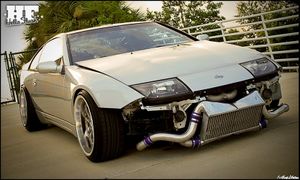Intercooler
An intercooler is a unit, functionally similar to a radiator, that cools the intake air of a turbocharged (or supercharged) car.
Operation
Turbochargers and superchargers force and compress air into the intake of the engine for increased performance. A side-effect of compressing the air is that it heats up. Because hotter air has a higher chance of detonation, intercoolers are placed in the intake tract after the turbocharger, but before the throttle body, to help cool the recently-compressed air before it enters the engine.
On Z32s
The Twin Turbo model Z32 features parallel twin air-to-air intercoolers. This means that air passes through the cooling fins (much like a radiator) to cool the air passing through the inside of the intercooler. Some vehicles use water-to-air intercoolers, which use water to cool the charge air. The Z32's intercoolers are considered "side mount intercoolers" or "SMICs" being that there is one mounted on each "side" of the vehicle. Though they are still mounted to the front side of the vehicle, because they're on the "corners," they're not considered "front-mount intercoolers" or FMICs.
All OEM Z32 intercoolers are the same.
Aftermarket
The stock Z32 intercoolers are small and often considered largely ineffective in cooling the charge air. There are several upgrades available, most of which offer a thicker core, larger face, and more efficient airflow compared to the original intercoolers. Some also switch to a front-mount intercooler, either for appearance or potential performance gains.
It should be noted that most (not all) FMICs reverse the "crossover" effect the Z32's intake design naturally incorporates. That is, on a stock setup, the driver's side turbocharger feeds air to the passenger side cylinder bank, due to the path created by the upper intake manifold. This is to maintain a balance in air between the two banks (as a turbocharger producing less air will provide less air for the opposite cylinder bank, whose turbocharger will then be limited by the amount of air fed from the first side). Many front mount intercoolers have the air cross the entire face of the intercooler, so the intake air essentially crosses twice (once at the intercooler and once in the intake manifold), eliminating this "safety net."
Related Articles

